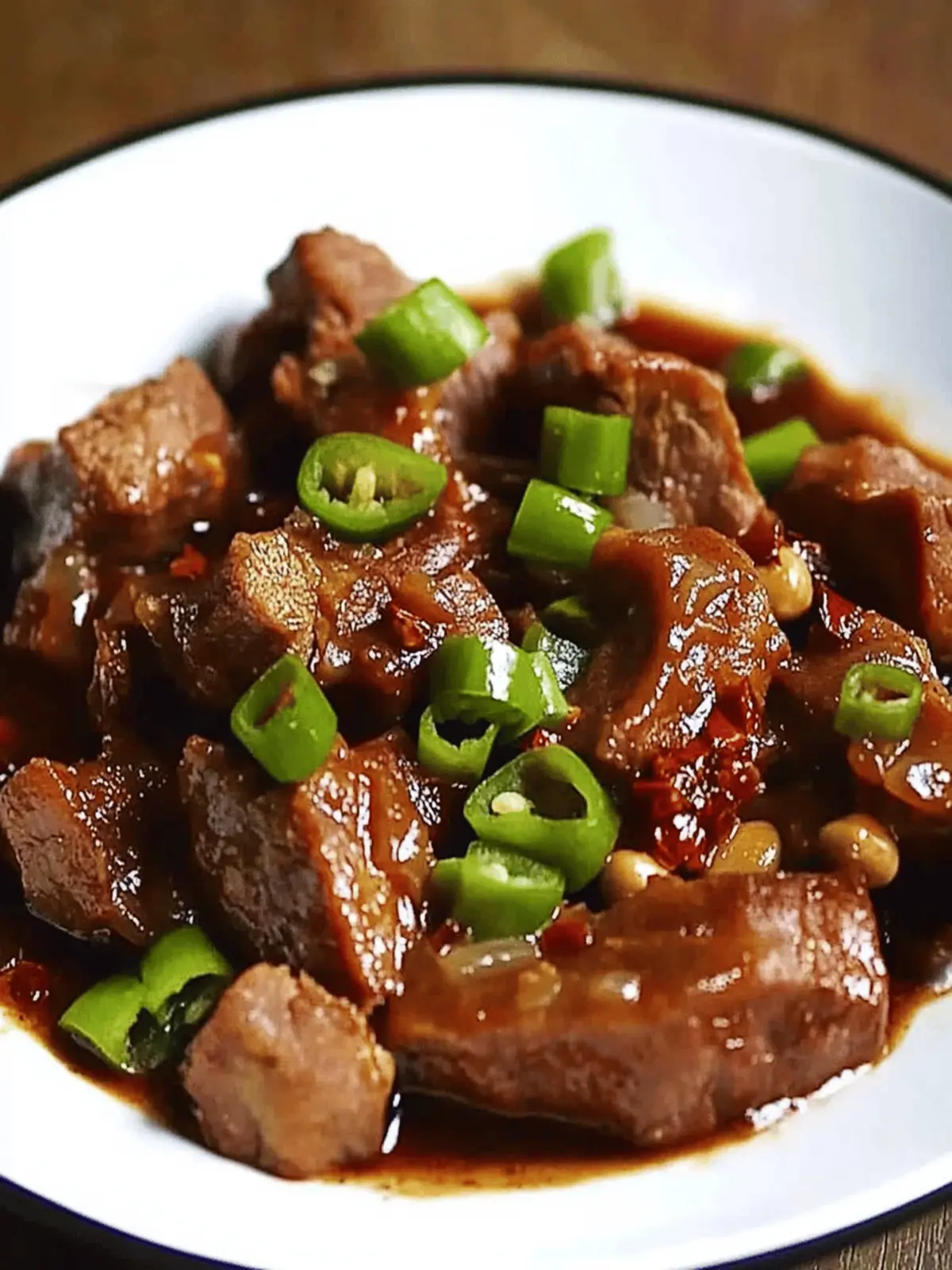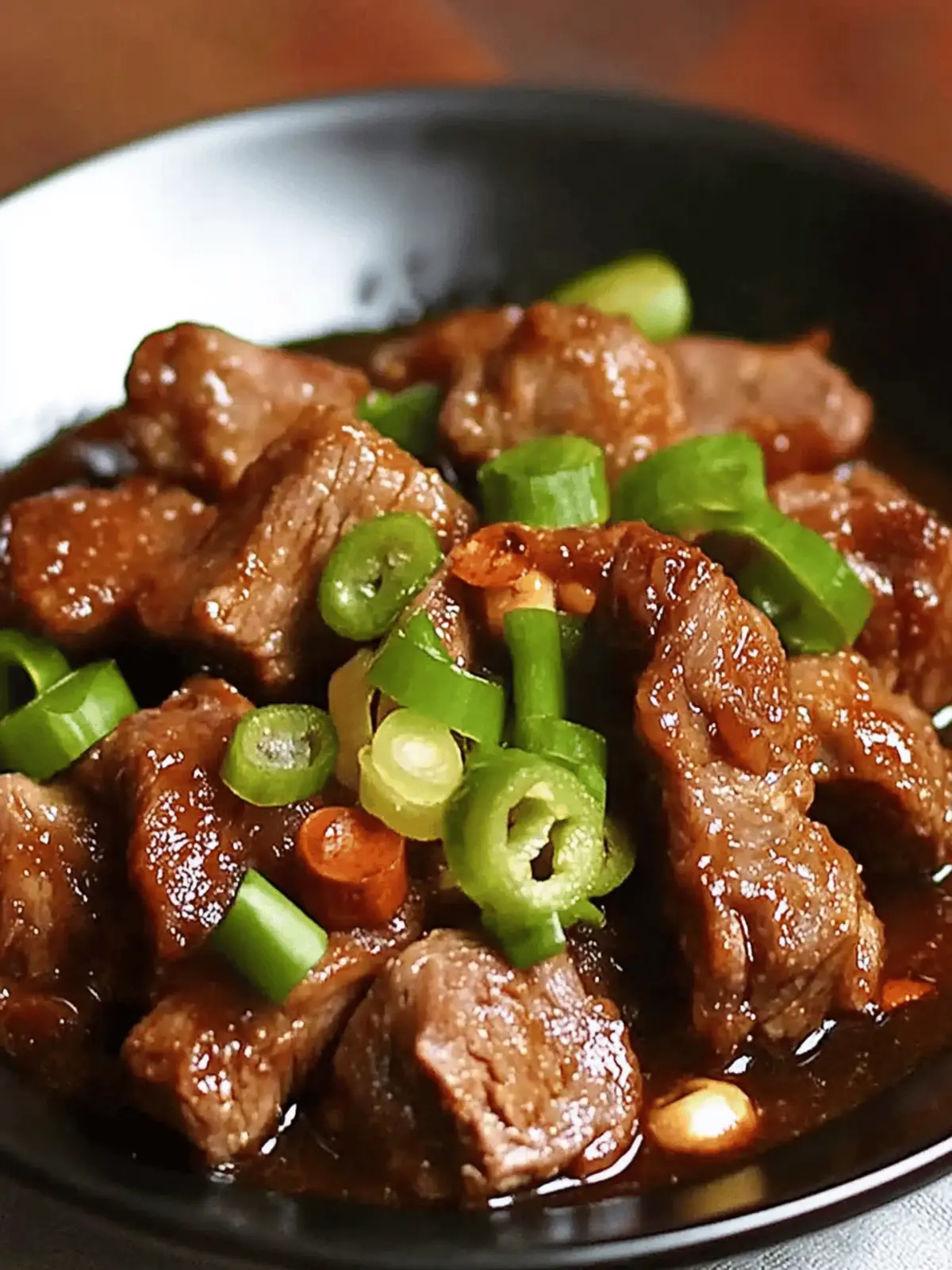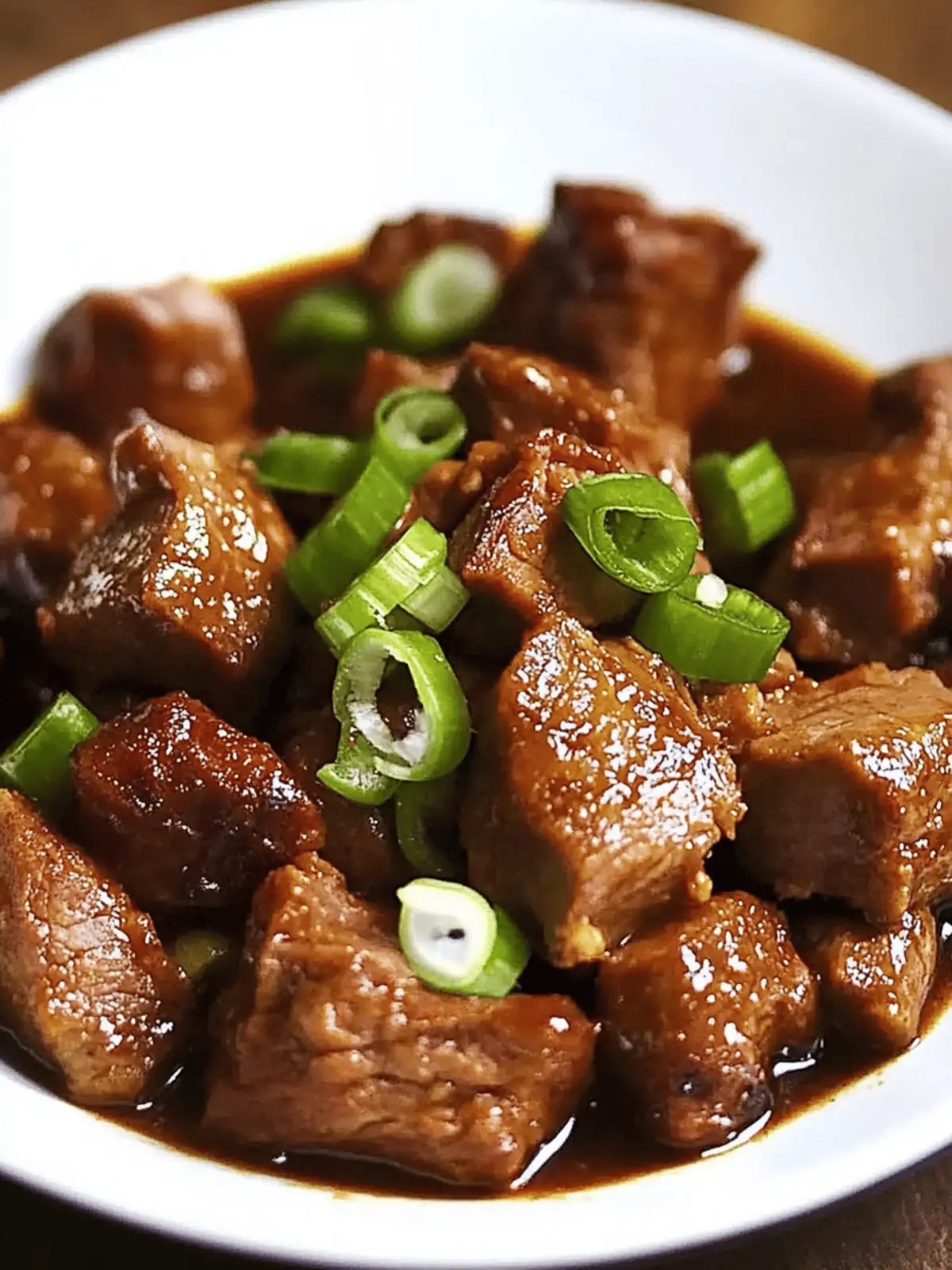There’s a special kind of comfort that comes from cooking a hearty meal, especially when it fills your kitchen with enticing aromas. Recently, I decided to explore the vibrant flavors of Southeast Asia, and that’s when I stumbled upon the unique recipe for Tamarind Pork. The sweet-and-sour depth of tamarind combined with succulent pork shoulder creates a dish that not only warms the soul but also impresses anyone lucky enough to share it with you.
As the tamarind paste melds with the rich soy sauce and fish sauce, you’ll feel as though you’ve traveled to a bustling market, surrounded by tantalizing dishes you’d never want to end. This Tamarind Pork recipe is perfect for those evenings when you crave something truly special without sacrificing too much time in the kitchen.
In just a little over 45 minutes, you can serve up a mouthwatering meal that even the pickiest eaters will love—definitely a win against mundane weeknight dinners! Let’s dive into the layers of flavor, shall we?
Why is Tamarind Pork a Must-Try?
Flavor Explosion: Each bite delivers a delicious sweet-and-sour harmony that excites your taste buds.
Simplicity: Quick to prepare, it uses simple ingredients yet tastes gourmet, making it a great choice for home cooks of all skill levels.
Versatility: Perfect for a weeknight dinner or impressing guests, this meal adapts easily to your desired level of spice.
Crowd Pleaser: Its bold flavor profile ensures it will satisfy even picky eaters, making it an excellent choice for family gatherings.
Time-Efficient: Ready in about 50 minutes, this hearty dish lets you enjoy quality time with loved ones without spending hours in the kitchen.
Tamarind Pork Ingredients
For the Base
• Olive oil – 3 tablespoons for sautéing shallots and garlic to create a flavorful foundation.
• Shallots – 3, sliced to add a subtle sweetness and depth.
• Garlic – 3 large cloves, finely chopped, providing aromatic richness.
• Pork shoulder or stew meat – 1 pound, cut into 1 1/2-inch pieces, for tender and juicy bites.
For the Sauce
• Chicken stock – 2 cups to infuse the dish with savory goodness.
• Light brown sugar – 1/2 cup, balancing the tangy tamarind flavor in the dish.
• Tamarind paste – 1 1/2 tablespoons, the star of your Tamarind Pork, giving it that unique sweet-and-sour twist.
• Soy sauce – 1 tablespoon, enhancing the umami richness of the dish.
• Fish sauce – 1 teaspoon, adding depth and complexity.
• Shrimp paste – 1 teaspoon, for a savory punch that rounds out the flavors.
For the Garnish
• Dried shrimp – 1 tablespoon, finely chopped, to sprinkle on top for a delightful crunch.
• Jalapeño pepper – 1, thinly sliced, for a pop of color and a kick of spice.
With these ingredients at hand, you’re ready to embark on a culinary adventure that encapsulates the vibrant essence of tamarind, whisking your taste buds to Southeast Asia!
How to Make Tamarind Pork
-
Heat oil: In a large pot, warm 2 tablespoons of olive oil over medium heat. Once shimmering, add the sliced shallots and garlic, cooking for about 2 minutes until fragrant and softened.
-
Brown pork: Add the pork shoulder or stew meat to the pot. Sauté, turning occasionally, until the pork is browned on all sides, creating a lovely caramelization.
-
Combine sauces: Stir in the brown sugar, tamarind paste, soy sauce, fish sauce, and shrimp paste. Mix well to ensure the pork is coated in this flavorful medley.
-
Simmer: Pour in the chicken stock and bring it all to a boil. Once bubbling, reduce the heat to a simmer, cover the pot, and let it cook for 45 to 50 minutes until tender, stirring occasionally.
-
Fry shrimp: While the pork simmers, heat the remaining tablespoon of olive oil in a smaller skillet over medium heat. Fry the chopped dried shrimp for about 30 seconds until aromatic and golden brown, then transfer to a paper-towel-lined plate to drain excess oil.
-
Serve: Once the pork has simmered, transfer the tender meat and sauce into a serving bowl. Garnish with the crispy fried shrimp and sliced jalapeños for that vibrant finish.
Optional: Serve with steamed rice to soak up the delicious sauce.
Exact quantities are listed in the recipe card below.
What to Serve with Tamarind Pork?
There’s nothing quite like creating a vibrant feast around a dish that captivates the senses.
-
Jasmine Rice: A classic pairing that absorbs the rich sauce beautifully, offering a fluffy contrast to the tender pork.
-
Stir-Fried Vegetables: Brightly colored veggies bring freshness and crunch, balancing the savory depth of the Tamarind Pork.
-
Coconut Milk Soup: A fragrant, creamy soup provides a delightful contrast to the dish’s tangy flavors, making every bite a new experience.
-
Crispy Spring Rolls: These little parcels add a satisfying crunch and can be filled with your favorite ingredients, enhancing your meal’s textures.
-
Mango Salad: The sweetness of ripe mangoes with a hint of lime freshness will elevate the dish, adding a zesty note that complements the pork perfectly.
-
Chili-Lime Drink: A refreshing drink with a hint of spiciness will cleanse your palate and enhance the rich flavors in the meal.
-
Sweet Sticky Rice: A perfect dessert to finish your meal, the sweetness of this sticky rice harmonizes beautifully after the tang of Tamarind Pork.
Tips for the Best Tamarind Pork
-
Marinate Ahead: For extra depth of flavor, marinate the pork in tamarind paste and spices for a few hours or overnight before cooking.
-
Adjust Sweetness: The balance of tamarind and brown sugar is key; taste as you go, adding more sugar for sweetness or tamarind for tang, to perfect your Tamarind Pork.
-
Avoid Overcrowding: When browning the pork, avoid overcrowding the pot to ensure it gets that lovely caramelization; work in batches if needed.
-
Fresh Ingredients: Use fresh shallots and garlic for maximum aroma and flavor. Dried shrimp should be fragrant—check their freshness before using.
-
Serve with Sides: Pair your Tamarind Pork with steaming jasmine rice or stir-fried vegetables for a well-rounded meal that enhances the dish’s flavors.
Tamarind Pork Variations
Feel free to put your own spin on this delightful dish for a unique twist that excites the palate!
-
Gluten-Free: Use tamari instead of soy sauce to keep it gluten-free without losing flavor.
-
Sweetener Swap: Substitute honey or maple syrup for brown sugar for a different type of sweetness.
-
Vegan Option: Replace the pork with jackfruit for a plant-based version that still captures the essence of tamarind.
-
Heat Level: Add crushed red pepper flakes or a pinch of cayenne to amp up the spice level for those who crave heat.
-
Coconut Cream: Stir in some coconut cream towards the end of cooking for a richer, creamier sauce that complements the sourness of tamarind beautifully.
For an added texture, you might consider frying up some diced bell peppers and onions along with the jalapeños for extra crunch and sweetness. Every variation brings a chance to create something that fits your taste while celebrating the original recipe!
How to Store and Freeze Tamarind Pork
Fridge: Store leftover Tamarind Pork in an airtight container for up to 3 days. Reheat gently on low heat to avoid drying out the meat.
Freezer: Freeze portions of Tamarind Pork in freezer-safe bags or airtight containers for up to 3 months. Thaw overnight in the fridge before reheating.
Reheating: For the best texture, reheat thawed Tamarind Pork on the stove over low heat, stirring occasionally until warmed through.
Room Temperature: Avoid leaving Tamarind Pork out at room temperature for more than 2 hours to ensure food safety.
Make Ahead Options
These Tamarind Pork dishes are perfect for meal prep enthusiasts! You can chop the shallots and garlic up to 24 hours in advance and store them in the refrigerator to save time on the day of cooking. Additionally, you can season the pork with the tamarind paste, soy sauce, fish sauce, and shrimp paste up to 3 days ahead. Just remember to keep the marinated pork covered in the fridge to maintain quality. When you’re ready to serve, simply follow the cooking steps, simmering the pork in the prepared sauce and finishing with the crispy fried shrimp and jalapeños. This way, you’ll enjoy a flavorful meal with minimal effort, making weekdays a breeze!
Tamarind Pork Recipe FAQs
How do I choose the right tamarind paste?
When selecting tamarind paste, look for a rich, dark brown color and a thick consistency. Avoid any that have dark spots or a watery consistency, as they may not have the concentrated flavor needed for your Tamarind Pork. I often recommend trying a few brands to find one that has the right balance of sweetness and tartness for your taste buds.
What’s the best way to store leftover Tamarind Pork?
Store leftover Tamarind Pork in an airtight container in the refrigerator for up to 3 days. Make sure to let it cool down to room temperature before covering it. When you’re ready to enjoy it again, simply reheat gently on low heat to keep the pork moist—nobody wants dry meat!
Can I freeze Tamarind Pork, and how?
Absolutely! To freeze Tamarind Pork, let it cool completely first, then transfer it into freezer-safe bags or airtight containers. Make sure to remove as much air as possible to prevent freezer burn. It can be frozen for up to 3 months. When you are ready to enjoy it, thaw it overnight in the fridge and reheat on the stove over low heat, stirring occasionally.
What should I do if the sauce is too sweet?
If you find that your Tamarind Pork sauce is too sweet for your liking, you can balance it by adding a bit more tamarind paste for an extra tart kick. Alternatively, a splash of soy sauce can add depth and saltiness that counters the sweetness. Don’t be afraid to taste and adjust as you go to ensure you reach your ideal flavor!
Is there a way to make this dish more suitable for my dietary restrictions?
Definitely! If you have dietary considerations, like allergies to shellfish, you can leave out the shrimp paste and dried shrimp or substitute them with a bit of miso paste for umami flavor. For a lower-sugar option, use coconut sugar or adjust the amount of brown sugar in the recipe to suit your preferences. Always feel free to customize your Tamarind Pork to your specific needs!
Can I use a different cut of pork for this recipe?
Yes, you can use different cuts like pork loin or tenderloin, but keep in mind that they might cook faster due to their leaner nature. If you choose these cuts, make sure to adjust cooking times accordingly—usually around 30 to 40 minutes—until the meat is tender but not overdone. The more the merrier in terms of flavors though—experiment and find what works best for you!

Mouthwatering Tamarind Pork: A Flavor-Packed Delight
Ingredients
Equipment
Method
- In a large pot, warm 2 tablespoons of olive oil over medium heat. Once shimmering, add the sliced shallots and garlic, cooking for about 2 minutes until fragrant and softened.
- Add the pork shoulder or stew meat to the pot. Sauté, turning occasionally, until the pork is browned on all sides, creating a lovely caramelization.
- Stir in the brown sugar, tamarind paste, soy sauce, fish sauce, and shrimp paste. Mix well to ensure the pork is coated in this flavorful medley.
- Pour in the chicken stock and bring it all to a boil. Once bubbling, reduce the heat to a simmer, cover the pot, and let it cook for 45 to 50 minutes until tender, stirring occasionally.
- While the pork simmers, heat the remaining tablespoon of olive oil in a smaller skillet over medium heat. Fry the chopped dried shrimp for about 30 seconds until aromatic and golden brown, then transfer to a paper-towel-lined plate to drain excess oil.
- Once the pork has simmered, transfer the tender meat and sauce into a serving bowl. Garnish with the crispy fried shrimp and sliced jalapeños for that vibrant finish.



